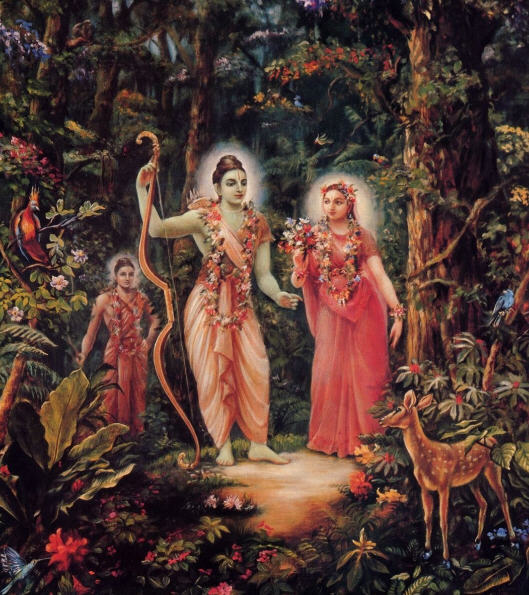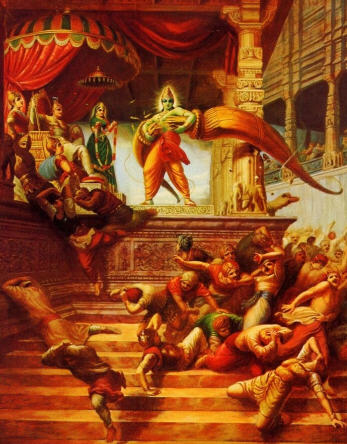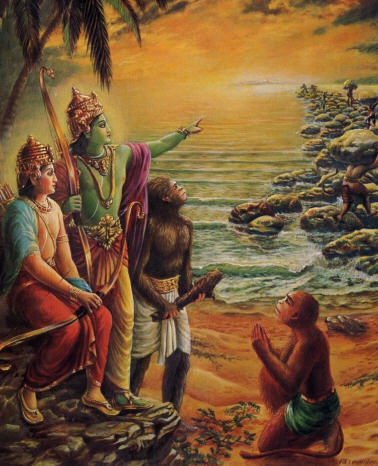Many ages ago God appeared on earth as the most benevolent ruler
and valiant hero the world has ever known.

Millions of years ago, according to Vedic sources, the Supreme Lord appeared on this planet as the warrior Ramacandra to execute His will and display the pastimes of the Personality of Godhead. The pastimes of Lord Rama are revealed in the famous Vedic scripture called the Ramayana, written by Sri Valmiki. The Ramayana is written down as a historical epic, but it contains the essential information of the original Vedas. The Ramayana and the Mahabharata (of which the famed Bhagavad-gita is a chapter) are especially recommended for the present age, even more so than the highly intricate Vedas or the philosophical theses of the Vedanta-sutra all of which are prone to misinterpretation in this fallen Age of Quarrel.
The Ramayana tells of how Lord Ramacandra appeared on earth in human form. He was of greenish hue. His bodily luster like fresh green grass.
What is written in the Ramayana, we should note here, is best understood as it is. When the pastimes of the Supreme Personality of Godhead are narrated, there can be no question of allegory. Allegory means a given text conveys a truth higher than the literal one. But the highest realization of spiritual perfection is that the Absolute Truth is a person. This precludes the possibility of going beyond Him to some higher truth. Although out of kindness to His devotees Lord Rama appeared as a man. He is the Supreme Lord, and His birth is transcendental in every respect and free of all material taint. His history is, therefore, marvelous and filled with wondrous feats, as we'll see.
Ramacandra was the son of King Dasaratha. He was the darling of His father and mother, Queen Kausalya, as well as the hero and darling of all Ayodhya, the capital of what was then the single world kingdom.
Growing old, King Dasaratha desired to confer the kingdom on his eldest son, Rama. As a joyous Ayodhya prepared to, coronate the beloved prince, one of the queens of King Dasaratha, Queen Kaikeyi, plotted to remove Rama from the kingdom so that her own son, Bharata, would take the throne. Persuaded by a crooked maidservant that Ramacandra would have Kaikeyi's son killed if He became king, Queen Kaikeyi I took advantage of two boons she had received from her husband in gratitude for service she had rendered to him. She called her husband to her rooms and requested the following boons: Let Ramacandra be banished to the forest for fourteen years. And let Bharata be installed as king. When King Dasaratha heard these requests, he fainted away in shock.
As an ideal ksatriya king, Dasaratha would stand by his promise to grant two boons to his queen, even when it meant a fate worse than death. His religion was truth, and he had to keep his promise.
When Lord Ramacandra received the awful news. He only replied, "Very well. I shall go from here and proceed to the Dandaka Forest for fourteen years with an unwavering mind."
The wife of Rama was the beautiful and chaste Sita. Lord Ramacandra had gained Sita when, in the assembly where Sita was to choose her husband. He had broken a bow that was so heavy it had to be carried by three hundred men. Rama thus satisfied Sita's father, Janaka, and married Sita, who was endowed with transcendental qualities. It is understood that, as Lord Ramacandra was Visnu, the Supreme Lord Himself, so Sita was actually Laksmi, the goddess of fortune. Being the daughter of the royal saint Janaka, she was accustomed to life as a princess. Yet when Ramacandra informed her that she must stay in the kingdom under the protection of Bharata during His exile, Sita replied with an offended air: "If You repair to the forest, I shall go in front of You and make smooth the path by crushing the thorns under my feet. I shall not leave Your company, nor will You be able to dissuade me. I shall feel no sorrow in passing a long time with You."
Laksmana, Ramacandra's beloved brother, had been there while Rama was speaking with Sita. He caught hold of Ramacandra's lotus feet, as it was unbearable for him to be separated from Rama. Rama tried to dissuade him. But nothing could turn Laksmana. Laksmana was determined to accompany Sita and Rama to the forest for their long exile.
Forest life for a royal prince was supposed to be an abominable insult, but Ramacandra managed to cheer Sita by pointing out the beauty of the natural setting. A forest is said to be a place in the mode of goodness, just suitable for cultivation of spiritual life.

While Rama, Sita, and Laksmana were exiled in the forest, the horrible Ravana entered their lives. Ravana was a great demon who had almost everything. Through long performances of austere penances he had gained great power. For the sake of war-mongering he had conquered the demigods Kuvera and Indra. He reigned on the island of Sri Lanka and possessed vast wealth and opulence. He and his "Rovers of the Night" roamed about killing and eating hermits engaged in spiritual practices in the forest. Ravana also had made a career of violating beautiful women wherever he found them, and he had a harem of hundreds who had surrendered to his material influence of wealth and strength.
Ravana believed himself to be unvanquishable. He disdained God. Perfect materialist that he was, he challenged even the existence of God. He challenged everything good and listened to no cautious counsel about the bad reaction that follows sinful acts. In challenging Rama by the abduction of His wife Sita, however, Ravana was choosing death, and he rushed headlong toward his inevitable fate.
To implement the abduction of Sita, Ravana called on his warlord, Marica. Ravana asked Marica to take the form of a golden deer and frisk in front of Sita. When Sita should wish to have the deer for her own, Rama and Laksmana would follow it and Sita could be abducted.
Thus Marica, in the form of a wonderful deer with silver spots and the sheen of jewels, appeared before Sita in the forest. He drew the mind of Sita, who asked Ramacandra to catch him for her. Ramacandra was, of course, cognizant that this might be the Raksasa magic of Marica, but He decided to go after the deer. If it proved to be Marica, He would kill him. After firmly ordering Laksmana to stay with Sita, Ramacandra pursued the deer. It became elusive, even invisible. Finally Rama resolved to kill it. He shot one deadly shaft, which entered Marica's heart like a flaming snake.
But with his last breath, Marica cried out loudly, "Alas, Sita! Alas, Laksmana!"
Waiting with Laksmana in the cottage, Sita heard the cries and believed them to be Rama's. She told Laksmana to go at once to help Rama. Although Laksmana dismissed the idea that Ramacandra could be in danger, Sita insisted that Laksmana go and find Him. In that way Ravana was able to find Sita alone, and he carried her off by force.
On a chariot pulled by asses, Ravana, often heads and twenty arms, flew through the sky clutching Sita. This act completely sealed Ravana's doom. Not only would he die for capturing another man's wife, but he would not even be able to enjoy her in the meantime, not even for a moment.
Unable to forcibly have his lust satisfied, Ravana could only threaten Sita that if after twelve months she did not turn to him, he would cut her into pieces and have his cooks serve her to him for a feast.
In the absence of Sita, Ramacandra was plunged into unalloyed grief. Laksmana attempted to draw off Rama's despair, but He was paid no attention. Finally the brothers found signs of Sita, pieces of her clothing from her struggle with Ravana and ornaments that had fallen from her as she had risen up in Ravana's chariot. Rama and Laksmana also received information from the dying Jatayu, ancient king of the birds, who had tried to stop Ravana as he had flown away. Jatayu informed Ramacandra and Laksmana that Ravana had kidnapped Sita. For help in getting her back, Jatayu recommended they form an alliance with Sugriva, the king of a race of monkeys.
Sugriva did indeed help, mobilizing his forces and sending them out in search of Sita. After months of futile searching, the armies began to lose hope. Some returned, and some dispersed to foreign lands. It was Hanuman, the chief counselor to the king, who learned of the kingdom of Lanka, far away in the Indian Ocean.
Hanuman resolved to travel through the air in search of Sita. Being the son of the wind-god, Vayu, Hanuman had the faculty for flight. In one leap he crossed the ocean to Lanka.

Reducing himself to the size of a cat, Hanuman steadily entered the capital of Ravana, carefully noting all the details. As a servitor, he was very concerned that at any moment he might be caught and ruin the project. "If I lose my life," thought Hanuman, "great obstacles will crop up for the fulfillment of my master's project." To this very day, Hanuman is eulogized by all saints and scholars of Vedic science as the ideal servitor for his unwavering dedication to Lord Ramacandra.
Hanuman searched all over for Sita, finally locating her in the heart of the dense Asoka forest. He assured her that he was from Ramacandra and promised her that They would soon be reunited. As Hanuman left, the island of Lanka, he single-handedly destroyed thousands of raksasa warriors and set fire to the entire city.
In millions, the army of the monkeys mobilized and marched to the ocean. The Lord then had His faithful servants, like Hanuman and Sugriva, hurl huge boulders into the sea, and by the Lord's supreme potency they floated on the water, forming a bridge to Lanka. The army then marched into Lanka under the very nose of the lord of the Raksasas. Soon hand-to-hand combat began, and great heroes from both sides fought to the death day after day. Finally, one by one, the great Raksasa chieftains fell before the unlimited powers of heroes like Hanuman, Laksmana, Sugriva, and Ramacandra. At the last, Lord Ramacandra slew Ravana with a brahmastra weapon released from His bow.
Valmiki tells of the origin of this weapon. It was handed down by Lord Brahma and passed from sage to sage. The brahmastra was smeared with fat and blood, and smoked like doomsday fire. It was hard and deep-sounding, and when shot by Ramacandra it cleft Ravana's heart in two, depriving him of his life.
Rama was then reunited with Sita, and the fourteen-year exile having ended, they returned to Ayodhya on a flower-bedecked airplane.
His Divine Grace A.C. Bhaktivedanta Swami Prabhupada explains the Lord's appearance as Ramacandra thus: "The comparative studies on the life of Krsna and Ramacandra are very intricate, but the basic principle is that Ramacandra appeared as the ideal king, and Krsna appeared as the Supreme Personality of Godhead, although there is actually no difference between the two. A similar example is that of Lord Caitanya. He appeared as a devotee and not as the Supreme Personality of Godhead, although He is Krsna Himself. So we should accept the Lord's mood in His particular appearance, and we should worship Him in that mood. Our service should be compatible with the mood of the Lord. Therefore, in the sastras there are specific injunctions. For example, to worship Lord Caitanya, the method is chanting Hare Krsna."
Sri Valmiki declares that he who always listens to this epic becomes absolved from sins. He who listens with due respect meets with no obstacles in life. He will live happily with his near and dear ones and get his desired boons from Ramacandra, the Supreme Personality of Godhead.
